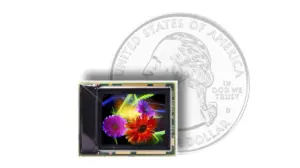Samsung Display is making significant strides in the development of LED on silicon (LEDoS) microdisplay technology for augmented reality (AR) devices. This technology may be poised to replace existing preferences for OLED on silicon (OLEDoS) displays (as used in Apple’s Vision Pro) and overcome their limitations in brightness, form factor, and lifespan.
During a conference held in Seoul, South Korea, hosted by TheElec, Gong Min Kim, the VP and head of the technology strategy team at Samsung Display, emphasized the potential of LEDoS to become the dominant display technology for AR devices in the future. To achieve this, Samsung is focusing on miniaturizing the LEDs while preserving their most desirable characteristics.
One of the major challenges in developing LEDoS lies in reducing the size of the LEDs while maintaining their performance. Kim revealed that Samsung is working on LED chips smaller than 10 micrometers and even 5 micrometers. Kim noted that LEDs in the range of 20 micrometers and 10 micrometers exhibited underwhelming performance and significant changes in characteristics. Consequently, he emphasized the importance of distinguishing between MicroLEDs, such as those used in AR devices, and MiniLEDs, typically found in TVs. The development of LEDoS aims to address these challenges and provide superior performance specifically tailored for near-eye AR displays.
In contrast to traditional flat panels, microdisplays prioritize pixels per degree rather than pixels per inch. Kim said that individuals with eyesight ranging from 0.8 to 1 require 30 to 40 pixels per degree, while those with eyesight between 1.5 to 2.0 necessitate 50 to 60 pixels per degree.
When referring to eyesight ranging from 0.8 to 1, it is typically a measurement of visual acuity using the Snellen chart or a similar visual acuity test. The numbers represent a fraction where the numerator (0.8 or 1) indicates the testing distance in meters, and the denominator (usually 6) represents the distance at which a person with normal vision would be able to read the same line on the chart.
For example, if someone has eyesight of 0.8, it means that they can read at a distance of 0.8 meters what a person with normal vision would be able to read from a distance of 6 meters. Similarly, someone with eyesight of 1 would be able to read at a distance of 1 meter what a person with normal vision can read from 6 meters away.
These measurements are used to assess visual acuity and determine the sharpness and clarity of an individual’s vision. They indicate how well someone can discern fine details and distinguish between objects at a given distance.

